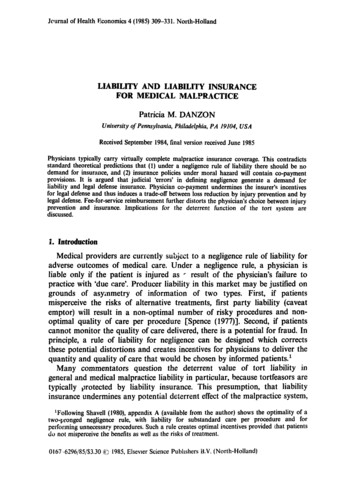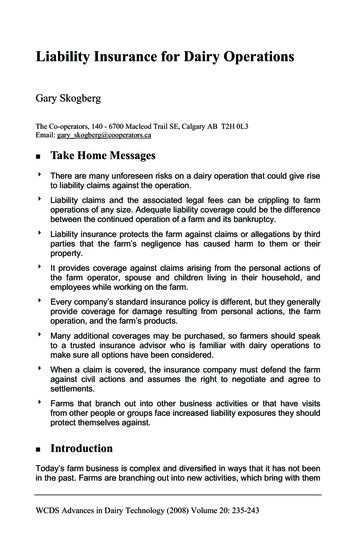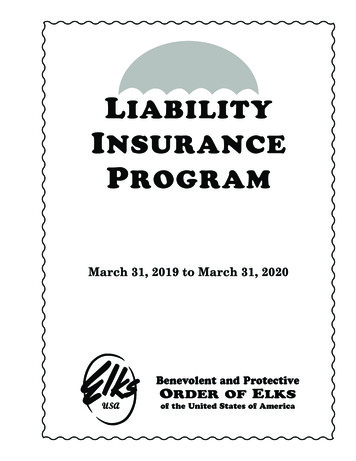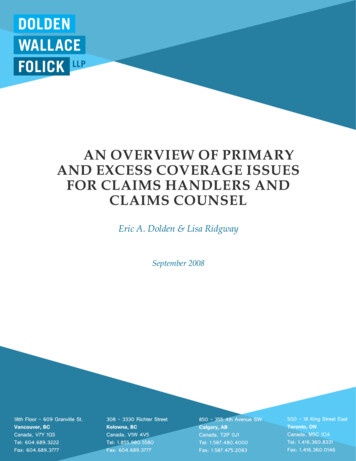
Transcription
Journal of Health Economics 4 (1985) 309-331. North-HollandLIABILITY AND LIABILITY INSURANCEFOR MEDICAL MALPRACTICEPatricia M. DANZONUniversity of Pennsylvania, Philadelphia, PA 19104, USAReceived September 1984, final version received June 1985Physicians typically carry virtually complete malpractice insurance coverage. This contradictsstandard theoretical predictions that (1) under a negligence rule of liability there should be nodemand for insurance, and (2) insurance policies under moral hazard will contain co-paymentprovisions. It is argued that judicial ‘errors’ in defining negligence generate a demand forliability and legal defense insurance. Physician co-payment undermines the insurer’s incentivesfor legal defense and thus induces a trade-off between loss reduction by injury prevention and bylegal defense. Fee-for-service reimbursement further distorts the physician’s choice between injuryprevention and insurance. Implications for the deterrent function of the tort system arediscussed.i. IntroductionMedical providers are currently subject to a negligence rule of liability foradverse outcomes of medical care. Under a negligence rule, a physician isliable only if the patient is injured as 1 result of the physician’s failure topractice with ‘due care’. Producer liability in this market may be justified ongrounds of asymmetry of information of two types. First, if patientsmisperceive the risks of alternative treatments, first party liability (caveatemptor) will result in a non-optimal number of risky procedures and nonoptimal quality of care per procedure [Spence (1977)]. Second, if patientscannot monitor the quality of care delivered, there is a potential for fraud. Inprinciple, a rule of liability for negligence can be designed which correctsthese potential distortions and creates incentives for physicians to deliver thequantity and quality of care that would be chosen by informed patients.lMany commentators question the deterrent value of tort liability ingeneral and medical malpractice liability in particular, because tortfeasors aretypically protected by liability insurance. This presumption, that liabilityinsurance undermines any potential deterrent effect of the malpractice system,‘Following Shave11 (1980), appendix A (available from the author) shows the optimality of atwo-pronged negligence rule, with liability for substandard care per procedure and forperforming unnecessary procedures. Such a rule creates optimal incentives provided (hat patientsdo not misperceive the benefits as well as the risks of treatment.0167-6296/85/ 3,30 1985, Elsevler Science Publishers B.V. (North-Holland)
310P.M. Danzon, Liability and liability insurance for medical malpracticeis the basis for several recent proposals for tort refoxm2 But in a rigorousanalysis of the eflect of liability insurance on incentives for prevention,Shave11 (1982a) concludes that ‘liability insurance does not have an undesirable effect on the working of liability rules . . . the terms of insurancepoliciessold in a competitive setting would be such as to provide anappropriate substitute (but not necessarily equivalent) set of incentives toreduce accident risks. In other words, it is not socially beneficial for thegovernment to intervene’.Under an ideal negligence rule with perfect information, the issue is moot:the optimal due care standard is defined to require the level of preventionwhich minimizes the sum of the costs of injuries plus injury prevention.Given such a rule, there is no demand for liability insurance because by thedefinition of the standard, it is cheaper to prevent than to insure injuries thatwould be deemed negligent. 3 In fact, the legal definition of negligence asdefined by Judge Learned Hand approximates such an efficient standard.Negligence is said to occur if the loss caused by the accident, multiplied bythe probability of the accident’s occurring, exceeds the burden of theprecautions the defendant might have taken to avert it.4But the evidence clearly contradicts the conclusion that there is nodemand for insurance under a negligence rule of liability. Physicians carryvirtually complete insurance, with high limits of coverage. Moreover malpractice insurance policies typically lack features designed to preserve theinsured’s incentives for loss prevention. There are no deductibles or coinsurance. Merit rating (rating on the basis of prior claims) is used lessfrequently than is statistically feasible.5 This apparent absence of policyprovisions designed to deter moral hazard is inconsistent with theoreticalpredictions [e.g., Arrow (1970), Zeckhauser (1970)] and empirical evidencefrom first party insurance and other lines of liability insurance, where copayment and merit rating are common. The purpose of this paper is toattempt to explain this discrepancy between theory and evidence with respectto the demand for medical malpractice liability insurance; to examine theoptimal form of liability insurance contract; and to reconsider the case forgovernment intervention in malpractice insurance markets.Section 2 shows how in principle a rule of liability for negligence can bedesigned to provide physicians with incentives to practice with the level of‘For example, ‘The extent to which the defendant must respond in damages is bettermeasured by the plaintifl’s harm than by the degree of the defendant’s fault . . . the notion of awrongdoing defendant is increasingly anachronistic in this age of widespread malpracticeinsurance. .’ [American Bar Association (19?7)].3The objection that people would still insure against their own ‘carelessness’ ignores thepurposeof the liability rule to influence the propensity to be careless. If the due care standard isdefined taking into account all relevant social costs, including the costs of avoiding ‘carelessness’,this objection is meanmgless.4U.S. v. Carroll Towing, 159 2d 169 (2d. Cir. 1947).‘Ralph (1981).
P.M. Damon, Liability and liability insurawe for medical malpractice311care that would be preferred by fully-informed patients. Section 3 examinesoptimal liability insurance contracts under a negligence rttle, under conditions of imperfect information, court error and costly legal defense, whichare excluded by assumption from the model in section 2 and in Shave11(1982a). It is shown that, in contrast to first party insurance, the optimalliability insurance policy under moral hazard is unlikely to include anautomatic deductible or coinsurance provision. Optimal co-payment inliability insurance is less than for first party coverage with equivalent moralhazard on the part of the policyholder. Because liability insurance typicallycovers damages and legal defense in a single policy, there is a trade offbetween providing incentives to the policyholder to reduce injuries andproviding incentives to the insurer to defend claims. These theoreticalpredictions are related to characteristics of medical malpractice insurancemarkets in section 4. Section 5 shows that the physician’s choice betweeninjury prevention and liability insurance may be further distorted by the taxtreatment of health insurance and by reimbursement practices of healthinsurers. Section 6 evaluates policy implications.2. Optimal liability rulesThe model is formulated in terms of medical injuries but could applyequally in any market context where consumers may be injured by productfailure which depends only on the care taken by producers. State-dependentutility of patients and physicians is assumed, because personal injuryplausibly affects the patient’s utility of income and liability claims imposeuninsurable time and reputation costs on physicians.Assume that expenditure on prevention affects the probability but not thesize of loss, and each patient buys just one unit of medical care.‘j Insurancefor first party or liability losses is available, with perfect experience ratingand a proportionate loading charge. The following notation is used:V(B) patient’s utility of initial wealth, V’ 0, V” 0,p(r) probability of injury, p’ CO, p” O,r quality (prevention) per unit of service,s price of service,c(r) production cost per unit, c’ 0, cn 0,L monetary loss to patient if injury occurs,M first party insurance coverage bought by patient,YP premium rate per dollar of first party coverage, where y 2 1 is theloading charge,6This abstracts from the eftwts of liability rules on quantity of services (see footnote 1). Themodel also assumes that physicians pay any judgment in excess of policy limits, ignoring thepossibility of bankruptcy or judgment proofing.
P.M.Danzon, Liability and liabilityinsurancefor medical malpractice312patient’s perception of p, h’ 0, h” C 0,physician’s utility of initial wealth, U’ 0, U” 0,damages paid by physician if a loss occurs,liability insurance coverage bought by physician, Q s D, premium rate per dollar of liability coverage, where A& 1 is theloading charge, Lagrange multiplier.h(p) U(A) :APc1Subscript 0 denotes the state in which an injury occurs. Subscript 1denotes the state in which no injury occurs. Subscripts J s and 111denote firstparty, strict and negligence liability, respectively.Initially, patients are assumed to be fully informed.First party liability.If patients are fully informed and markets are competitive, the physician chooses the level of safety (r) and product price (s) tomaximize expected utility of patients, E(V), subject to maintaining anopportunity level of utility, UC,determined by the physician’s alternative useof time.’ Patients select first party insurance coverage (M), given the supplyprice per dollar of coverage yp. Informed markets thus solve the followingoptimization problem:maM U -94 VJB-s-ypkfj pvop- - jw- M]M9s.r p(U[A s-c(r)]- UC .(1)Maximization with respect to M, s and r yieldsp V&p’ @‘,(2)(3)(4)where P’ (l-p)V; pV&Eq. (2) may be rewritten‘If the physician has monopoly power, UC includes some rent but the structure of the problemis not affected. The model ignores other possible arguments in a physician’s utility function, suchas prestige and ethics.
P.M. Damon, Liability and liability insurancefor medical malpracticev; 1-W- -51G Y-Was 21.313(2’)This is the familiar result, that optimal coverage does not fully equate themarginal utility of income if the insurance premium contains a proportionateloading charge (y 1). Eq. (4) shows that if injury entails irreplaceable loss(V, V,), optimal prevention (3) may exceed the optimal level with riskneutrality (c’ - p’L), even with full insurance of any monetary loss.Strict third party liability.Under a rule of strict third party liability thephysician pays for all iatrogenic injury. An omniscient benevolent dictatorwould choose the damage award (D), physician’s liabihtj insurance coverage(Q), prevention (r) and product price (S) to maximize the patient’s expectedutility, subject to maintaining the opportunity level of utility for physicians,UC,max d (l-p)VIIB-s] pVJB-s-L D]D,Q,s.r ,u{(l-p)U,[A S-c(r)-ApQ] pU,[A s-c(r)-ApQ-(D-Q)]-UC .Maximization with respect to D, Q, s and r yieldsv* ug,where O’ (i-p)U; pU&Eqs. (6) and (8) together implyv;vlvb vg n l-dPqasA 1 -The optimal tort damage award, D*, provides the level of insurancepatients would choose to buy voluntarily, but with the loading factor of the
314P.M. Danzon, Liability and liability insurance for medical malpracticephysician’s liability insurance. Thus D* 5 M, as Lg y. The optimal safety level(r,*) implicitly defined by eq. (9) may exceed or fall short of r; under firstparty liability as ( U1 - U,)/o’ LQ yM.If n y 1 and the physician incurs no uninsurable liability loss, thenr* r f. Under the more reliastic case of I y and U1 U0 because of timea/nd reputation costs of suit, the optimal level of prevention is higher understrict liability.Negligence.Under a negligence rule, the physician is liable only if he failsto meet the due care standard, r,*, and the patient is injured. The socialwelfare function is given by eq. (1) for r r,* and by eq. (5) for r r,*. If eitherU is state-dependent or A 1, the physician is not fully insured against theloss. The social welfare function is discontinuous at r,* because of the costs ofsuit to physicians.A first best solution can be achieved by setting D at D*, the optimalcompensatory award under strict liability, and r,* r The physician’sdecision problem is then to choose Q, s and r to maximize E(V), subject toE(U) UC and subject to the penalty D D* if r r,*. But this privateobjective function is identical to the social welfare function, i.e., it is adiscontinuous function equal to eq. (1) for r r,* and equal to eq. (5) forr rz. If either ;l y or U. U1,the physician’s incentive is to choose r--r,*,i.e., to be non-negligent and hence have no demand for liability insurance.On the other hand, if 1 il y and U is not state-dependent, then physicianswould choose r r,*, i.e., would choose to be negligent and to insure theresulting losses. As a practical matter, this case can be ignored.*Imperfect information. The analysis so far has shown that if consumers arefully aware of risks, first party liability and negligence are equally efficientand superior to strict liability, when shifting liability imposes uninsurablelosses on defendants.g But if consumers underestimate risks, under first partyliability they buy too little insurance and non-optimal safety. Spence (1977)shows that under strict liability, a first best solution with respect tocompensation and prevention can be achieved by means of a two-partpenalty. A compensatory award equal to D* is paid to victims. A line, paidto the state initially but refunded as a subsidy to the hazardous activity, isset equal to (1 - h’)((V, - V,)/P’), where h(p) is the consumer’s perception of pand (VI - IQ/P is the dollar measure of loss due to injury, or the willingnessto pay for injury reduction.*If I y 2 1, it might be optimal to provide compensation through first party coverage andimpose a liability line on physicians to achieve optimal deterrence. Enforcement would dependon subrogation actions by the patient’s first party insurer against the physician or his liabilityinsurer.‘This analysis ignores costs of adjudicating claims, which would probably be highest for strictliability, lowest for first party liability.
P.M. Danzon, Liability and liability insurance for medical malpractice315With .a risk averse defendant and incomplete insurance, provided thestandard of care is correctly set at r& the line necessary to achievecompliance is less under negligence than under strict liability because of thediscontinuity of the pay-off function. lo The physician will choose to meetthe standard providedThus if the load on liability insurance is at least as great as the load on firstparty insurance (22 y), a fine over and above the compensatory award paidto victims is not necessary to induce compliance with a negligence standard, ifthe uncompensated cost of suit to physicians ( U1 - U,)/o’ exceeds the distortionin market incentives due to consumer misperceptions ((V, - Vo)/B’)(1 -K/p’).Since the fine-subsidy mechanism is presumably costly to administer, this isan added attraction of a negligence rule over strict 1iability.l’The demandfor liabilityinsuranceIt has been shown that, under a negligence rule with the standard of careand rule of damages optimally defined, physicians have incentives to be nonnegligent. Hence there should be no demand for liability insu -ante.This argument presupposes that courts enforce an e;;lcient due ZLXstandard with perfect accuracy, and that this is known tc” physicians zndpatients. The demand for liability insurance can arise out of &EitherT;-pe 1 orType 2 errors by the courts, or penalties insufficient to offset c *nsumermisperception of risk. l2 If courts set the standard too high, j nldingphysicians liable for some injuries where the cost of prevention exceeds theexpected benefits (Type 2 errors), it is cheaper for the physician to insurethan to’ prevent these injuries, and this is socially optimal. But if victims orcourts also commit Type 1 errors, failing to file or to find liability in all Frlteinstances of negligence, or if liahi&ty payments are too low, then it is cheal)erfor the physician to insure than trs avoid some instances of negligence, andthis is not socially optimal.These two cases are illustrated in fig. 1. The curves labelled FF and ESshow the marginal social benefits of care per patient encounter, under firstparty and strict liability respectively, with fully informed consumers andloThis is analogous to the result in Diamond (1974), that there is a non-trivial range withinwhich the due care standard can fall and still induce compliance.l ‘Reform of tort awards along the lines implied by this analysis is discussed in Danzon (!984).tZThe Type 1 and Type 2 errors here are errors in the court’s perception of the physman’slevel of care. Simon (1982) analyzes Type 1 and Type 2 diagnostic errors by the physician, butassumes that courts are perfectly informed about both the true condition of the patient and thephysician’s level of care.
316P.M. Damon, Liability and liabilityinsurancefor medical malpracticecourts. Under first party liability, the marginal beneflt of additional care (FF)is simply the reduction in probability of injury to the patient, which isassumed to be subject to diminishing returns. Under strict liability, there isan additional benefit from care if the physician incurs some uninsurable lossof time, reputation or inconvenience in responding to claims, so SS FF. Theri rir;Prevention perpatient encounterFig. 1. Optimal prevention under first party, negligence and strict liability.curve labelled CC shows the marginal cost of care. The discontinuous heavyline NN shows the marginal social benefits of care under a negligence rulewith the due care standard, r,*, optimally set equal to rJ*,the level that wouldbe chosen by fully informed patients. NN is discontinuous at r,* because forlevels of care that equal or exceed that level, the physician meets the due carestandard; hence he bears no liability.Type 1 errors (failure to file or find liability in all instances of negligence)or a suboptimal penalty if negligent imply a downward shifting of NN.Provided the vertical segment of NN intersects CC at r,*, physicians will stillchoose to be non-negligent. But if the Type 1 errors are sufficiently large, theintersection occurs to the left of r . It is then cheaper for physicians topractice with less than due care and to purchase liability insurance than tobe non-negligent.Type 2 errors consist of setting the standard to the right of r,*. As long asrr r, r:, physicians will meet the standard. But if r, r,*, it is cheaper forphysicians to choose r , i.e., to practice below the excessively high standardset by the courts and to insure against the resulting claims. Patients arethereby better off than if physicians adhered to the excessively high standard,but are worse off than if the standard were set at r,*, because medical fees riseto cover the additional prevention costs (rs-r,*) and physicians’ uninsureddisutility of suit.13131nprinciple, the additional cost of liability insurcnce is offset by a reduction in first partyinsurance costs.
P.M. Damon, Liabilityand liabilityinsurancefor medical malpractice317Casual evidence suggests that Type 1 errorsinate the demand forliability insurance. In medical and other linesfessional liability,thecourts defer to the customary practice of profes‘in good standing'asthe standard of due care, rather than apply the Hcost-benefit calculus ineach case. This creates a bulwark against Typerrors for above-averagephysicians but a presumption of Type 2 errors aconsequent incentive toinsure for those of below-average competence. hus the Type 2 errorshypothesis would predict that a substantial fracphysicianswould notbuy insurance, which is not the case. On ther hand, Type 1 errors,which give all physicians an incentive to buy in ante, are very common.Rough estimates suggest that at most 1 in 5 incidents of medical malpracticegive rise to a claim, and of these less than 50% are compensated.i43. Optimal liability insurancePerfectly informed insurers. Given errors by the courts in applying thenegligence rule, the optimal liability insurance policy (with zero load) wouldprovide fulk coverage of invaiid claims (Type 2 errors) and zero coverage ofvalid claims, assuming insurers could costlessly distinguish between valid andinvalid claims. The purpose of insurance would be protection against the risk. .Gf ji.idiCld CXiii - a risk that is beyond the control of the’physician. Such apolicy would preserve optimal deterrence while providing full coverage ofclaims for injuries not worth preventing. But obviously if the informationnecessary to operate such a policy were available to insurers, it would beoptimal for the courts to use the information and eliminate the errors whichgenerated the demand for insurance in the first place.Imperfectly informed insurers. In analyzing the optimal liability policy whenthe insurer cannot costlessly monitor the physician’s care ex ante ordiscriminate valid from invalid claims ex post, let us consider first thecontract that would be a private optimum, from the standpoint of thephysician.Damages coverage.Assume initially that courts adjudicate all claims costlessly, with some random error that cannot be influenced by legal defenser4Danzon (1985). Based on a review of a random sample of hospital records, CMA (1977)found a rate of iatrogenic injury of 4.65 per 100 admissions. Of these, 17.07% (or 1 per 126admissions) were determined by the reviewers to be instances where liability probably would befound (p. 97). Based on these injury rates, the estimated number of negligent injuries inCalifornia hospitals in 1974 was 23,800. Averaging over 1976-1978, the number of malpracticeclaims filed arising out of hospital-based injuries was roughly 2,376 [NAIC (1980)]. This impliesat most 1 in 10 malpractice victims filed a claim. Since 1978, the frequency of claims has roughlydoubled; there are no current data on iatrogenic injury rates. Assuming no change in thenumber of negligent injuries (which is plausible if the rate of admissions has increased but therate of injury per admission has decreased), the current frequency of claims per negligent injurywouid be 1 in 5.
318P.M. Danzon, Liabiky rind liability insurance for medical malpracticeeffort, such that the demand for liability insurance is only to cover damagepayments to plaintiffs. For damages insurance alone, many of the resultsfrom analyses of optimal first party insurance contracts app1y.l’ Assumingthat both the probability and .size of loss depend to some degree on thephysician’s care, optimal co-payment would include a deductible and COinsurance. Since the risk being insured against is invalid claims, it may beoptimal for the insurer to invest in information beyond the simple fact that sclaim was filed, in order to determine the probable validity of the claim. Inparticular, if courts are better informed than are claimants, such that validclaims have a higher probability of a plaintiff verdict, then optimal copayment would be higher on claims the plaintiff wins than on claims theplaintiff loses. But if court error is significant, it may pay for the insurer toundertake an independent review of claims and require co-payment only onthose which the reviewers deem negligent, rather than rely on the judicialprocess and require co-payment on all paid claims.The optimal co-payment rate on paid claims is lower (optimal level ofcoverage is higher), the higher the ratio of invalid to valid claims and thehigher the cost to the insurer of discriminating between valid and invalidclaims ex post. This is because co-payment can only affect the physician’slevel of care. But by assumption of a high ratio of invalid to valid claims,increased effort at injury prevention has little impact on liability losses.16One important implication is that if it is very costly for patients, courts andinsurers to distinguish between valid and invalid claims, optimal coverage ishighest for those specialties where the normal risk of adverse outcome, givennon-negligent care, is relatively high.These conclusions are derived from the principles of first party insurance,where the policyholder insures against loss to himself and the policy whichmaximizes policyholder utility is also socially optimal. This presumption maynot apply to insurance against liability to third parties, particularly in thecase of personal injury involving irreplaceable loss. Thus there may bedivergence between the private optimum (for the physician policyholder) andthe socially optimal liability insurance contract.However the analysis above implies that physicians’ choices of liabilityinsurance will also be socially optimal provided either (1) patients perceiverisks accurately, such that the value they place on safety is reflected in feesthey are willing to pay for medical care, or (2) tort damage awards are set tocorrect for patient misperceptions or other social costs that are not inter15For example, Mossin (1968), Arrow (1970), Zeckhauser (1970). Harris and Raviv (1978).16This is analogous to Shavell’s result in the first party context, that optimal coverageapproaches complete coverage if the cost of &are is very high [ShavePI (1979)J. I ignore here thepossibility that invalid claims may be non-random across physicians, being determined partly bya physician’s practice characteristics (type of patient, case complexity, bedside manner). This isconsidered in part 4.
P.M. Danzon, Liability and liability insurance for medical malpractke319nalized through medical care markets. Thus competitive liability insurancemarkets-will tend to devise monitoring and contract terms which distinguishType 2 errors from valid claims. Provided damage awards are optimally set,such contracts will also be socially optimal, because by definition Type 2errors are claims for injuries not worth preventing.Legal defense insurance. The analysis so far has assumed that the outcomeof a claim, once filed, depends only on an exogenously determined decisionof the courts. In fact, the outcome can be greatly influenced by the legaleffort of plaintiff and defendant. ” The need to provide for legal defensealters the form of the optimal liability insurance contract considered so far.If the defendant physician were risk neutral, knew the production functionof legal defense and could costlessly monitor the defense effort, he could hiredefense attorneys by the hour. To the extent physicians are risk averse, theymay seek insurance against such expenditures. In considering the optimalform of insurance for both legal defense and damage payments to plaintiffs,note that the physician’s effort at injury prevention now affects the loss ofboth the legal defense insurer and the damages insurer; and the liability lossof the damages insurer also depends on the legal defense effort of thephysician or his legal defense insurer.For several reasons, it is likely to be efficient to provide legal defenseinsurance’together with damage insurance in a single policy. First, since boththe legal defense insurer and the damage insurer face a risk of moral hazardwith respect to the physician’s incentives to prevent injuries, economies ofscale argue for a single monitor. Second, if the physician has full damageinsurance which is imperfectly experience rated, his incentive for lossreduction by legal defense effort is reduced. Thus if the damage insurer werenot also the legal defense insurer, he would have to monitor the physician’slegal defense effort. But with incomplete damage coverage, both the physicianand the damages insurer would have a stake in monitoring the legal defenseeffort. If the damages insurer has greater expertise in monitoring legal defensebecause of more frequent usage, this is a further reason for combining legaldefense with damages insurance.Summarizing, liability losses create a demand for both legal defense anddamage insurance. It is likely to be optimal to provide both in a singlepolicy, to prevent duplicative monitoring of the policyholder’s effort at injuryprevention and duplicative monitoring of defense attorneys.However, combining legal defense and damage coverage in a singleliability insurance policy creates a reverse moral hazard risk. The physician isexposed to moral hazard with respect to the insurer’s legal defense effort,“PlaintilT and defense legal expenditures each average about one half of net compensationreceived by plaintiffs.
320P.M. Damon, Liability and liability insurance for medical malpracticeunless the insurer bears the full cost of damages. But damages coverage withzero co-payment would undermine the physician’s incentives foq injuryprevention. Moreover if the coverage for damages does include a co-paymentbut related to valid cl;ims only, as was argued would be optimal, physicianswould want to monitor the drawing of the distinction between valid andinvalid claims. Absent such monitoring, the insurer has an incentive todeclare all claims valid and hence subject to co-payment. Thus where boththe insurer and the policyholder can affect the probability or size of loss, nosimple loss sharing contract can simultaneously provide both with correctmarginal incentives. In general, if it is costly for physicians to monitor theliability insurer’s legal defense effort, the optimal level of co-payment is likelyto be lower than on a first party coverage with comparable policyholdermoral hazard in in’rry prevention.To see the effects of insurer moral hazard on the physician’s optimal copayment, assume that the size of loss, D, can be reduced by the insurer’sdefense e&t, 5 with D, 0, Dff 0. The insurer’s potential liability is simplythe physician’s level of coverage Q, which may be de
310 P.M. Danzon, Liability and liability insurance for medical malpractice is the basis for several recent proposals for tort refoxm2 But in a rigorous analysis of the eflect of liability insurance on incentives for prevention, Shave11 (1982a) concludes that 'liability insurance does not have an unde-










